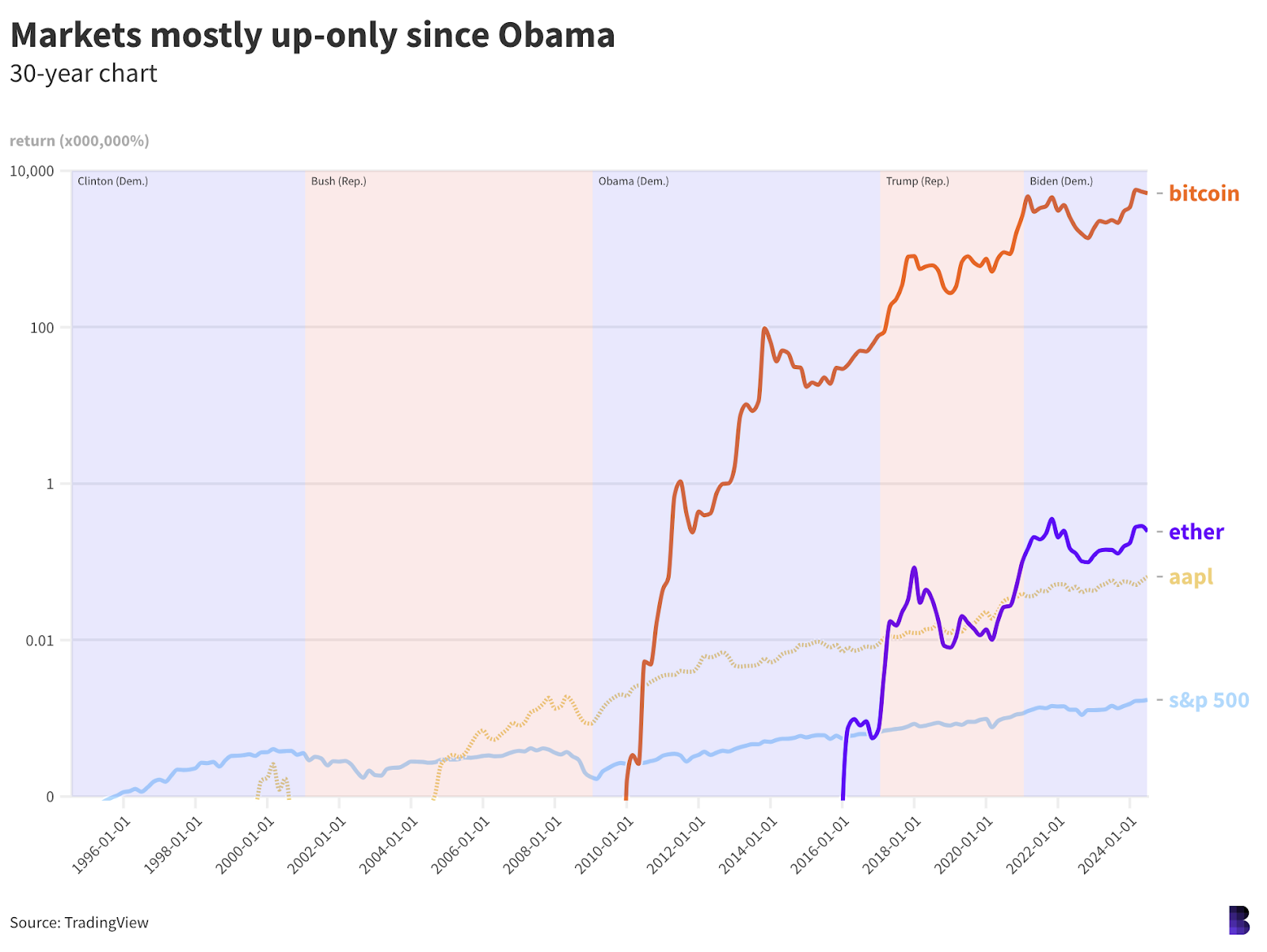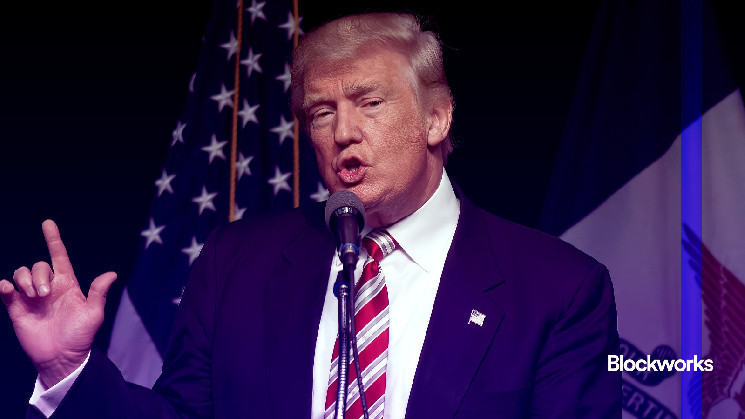Empire Newsletter: How US presidencies map to crypto markets
 blockworks.co 25 July 2024 13:21, UTC
blockworks.co 25 July 2024 13:21, UTC Today, enjoy the Empire newsletter on Blockworks.co. Tomorrow, get the news delivered directly to your inbox. Subscribe to the Empire newsletter.
Moon signals
It’s been said that the stock market is like astrology for dudes in finance.
If that’s the case, then mapping politics to markets must be akin to crystal healing, or animal magnetism.
Let’s not let that get in the way of a good time.
Republican nominee and former President Donald Trump is scheduled to appear later this week on stage in Nashville at Bitcoin 2024.
It’s set to be a landmark event for Bitcoin and the broader crypto space. It’s not the first known instance of a former US president participating in an industry event — President Bill Clinton took that honor alongside former UK Prime Minister Tony Blair at Sam Bankman-Fried’s Crypto Bahamas Conference in April 2022.
Terra would implode a few weeks later and FTX collapsed six months after that, mostly under the weight of Bankman-Fried’s fraud. He was later sentenced to 25 years in prison, almost 700 days after the Bahamas event.
Fingers crossed Trump’s appearance at Bitcoin 2024 bodes better for crypto.
And there are plenty of folk who believe that it will. Same with Trump’s positivity towards Silicon Valley — the general consensus being that the tech-heavy stock market will have more room to run under a second Trump administration.
And while the Nasdaq has decoupled from bitcoin over the past three weeks, what’s good for tech stocks is still considered pretty good for crypto.
Now’s time for the crypto’s political palm reading. Five different administrations have directed American politics over the last 30 years, two Republican (Bush and Trump) and three Democrat (Clinton, Obama and Biden).

Markets under Bush struggled. He came in just as the dot-com bubble burst at the turn of the millennium and quickly pulled the US into wars in Afghanistan and Iraq, which together lasted two decades.
The S&P 500 dipped more than 20% in the four months following Obama’s win in November 2008. But since then — a period that includes both Trump and Biden presidencies — stocks have mostly trended upwards, sans a few hiccups (like the Covid crash) and an eight-month stretch in 2022, when the S&P also retraced by over 20%.
Satoshi Nakamoto mined the first Bitcoin block less than three weeks before Obama first took office. Bitcoin, the currency, exploded by nearly 80 million percent across his two terms, alongside the launch of thousands of cryptocurrencies, including ether.
Were Obama and the Democratic Party at all responsible for all that crypto-wealth generation? Are you feeling particularly moody today because the full moon is in Capricorn this time of year? Who’s to say.
For what it’s worth, it’s really under Trump that “crypto” flourished into the mainstream. Bitcoin’s $20,000 all-time high, the Ethereum ICO boom and DeFi Summer all happened with Trump in the White House.

Crypto’s total market cap went from $1 trillion to as much as $3 trillion in Biden’s first year. But the second was marred by a series of debacles for crypto, the biggest shown on the dotted lines on the chart above.
And even despite bitcoin’s surge to new all-time highs, the rest of the crypto market still hasn’t returned to its 2021 peak.
Bulls would say a second Trump term could make all the difference. But with Mercury going into retrograde a few weeks after the election in November, anything could happen.
— David Canellis
Data Center
- BTC and ETH are down 3.7% and 8.5% apiece after the S&P 500 posted its worst day since 2022 (BTC: $64,000; ETH: $3,180).
- TRX is the only top-100 cryptocurrency still in the green over the past day, up 1.3%.
- LDO and the newly-formed AI supertoken ASI (still trading as FET) are the worst hit over the past week, slipping 20% and 17%, respectively.
- ETH ETFs saw $133.3 million in net outflows on Wednesday, their second day of trading, bringing the cumulative total to negative $26.7 million.
- Weekly Ethereum and Solana NFT sales volumes are up 16.5% and 19%. Ethereum leads with $34 million to Solana’s $28.25 million. Bitcoin recorded $18.8 million.
Times are a-changin’
How the turn tables.
That’s one way to think about former President Donald Trump’s shift in stance when it comes to crypto.
Last election, Trump was staunchly anti-crypto. He even tweeted (back when journalists, myself included, reported on his posts) that he was not a “fan” of bitcoin and crypto.
“Unregulated Crypto Assets can facilitate unlawful behavior, including drug trade and other illegal activity,” he said at the time. Looking back on it now, it almost seems like something Senator Elizabeth Warren, D-MA, would say given her staunchly anti-crypto stance.
Trump even went after the now-defunct Libra stablecoin project from Facebook (before it was Meta), claiming that it would need a banking charter.
Now one has to wonder how he’d approach such a project, given his support for the crypto industry this election.
I feel the need to note that we haven’t seen Trump float any actual policies for crypto. Similarly, though, we have yet to see or hear anything on the industry from Vice President Kamala Harris’ campaign. Her camp did turn down an offer to appear at Bitcoin 2024, unlike both Trump and Robert Kennedy Jr.
Trump, however, has already made strides not only by hosting events and making appearances with folks in crypto, but also by becoming the first major party nominee to accept crypto donations to his campaign earlier this year.
And, in a way, when you look back on the price of bitcoin throughout the years, there’s a far-fetched argument that Trump’s always been good for it — even when he was staunchly anti-crypto.
Take a look at 2016, for example. After Trump’s victory, bitcoin was boosted to over $730. In fact, it was one of the few sectors to actually benefit from the 2016 election victory. The futures for the major indices on Wall Street all sold off pretty abruptly. And so started bitcoin’s journey as a safe-haven asset… but I digress, let’s go back to Trump.
In 2021, Trump continued his vocal anti-crypto approach. He said that bitcoin “just seems like a scam.” He added later that year that crypto investing was “potentially a disaster waiting to happen.”
Given what was just around the corner, with the depegging of Terra’s algorithmic stablecoin and the shitshow that was FTX, he may not have been totally wrong on that one, if we’re being fair. But alas, no one had a crystal ball to really see what was lying in wait for the industry.
I think I’ve made my point: There’s a very detailed history of Trump favoring the US dollar over crypto. But something’s changed this cycle.
Oh how I’d love to be a fly on the wall (and a time traveler to boot) to hear some of the conversations the Trump campaign had around crypto this year, given the narrative shift.
— Katherine Ross
The Works
- Galaxy Asset Management, Michael Novogratz’s company, raised $113 million for a new crypto fund, per Bloomberg.
- CB Payments Ltd, the payments processor linked to Coinbase, was fined over $4 million by the UK government.
- Hashdex filed an S-1 for an ETF that would hold both ether and bitcoin, a first for the US.
- Bitstamp said it will start distributing Mt. Gox bitcoin and bitcoin cash on Thursday.
- Lumerin’s decentralized AI project Morpheous went live on the Arbitrum Test Network, CoinDesk reported.
The Riff
Does crypto revolve around the US?
I think the narrative tends to, but maybe not so much the entire ecosystem.
The US, when looking at crypto, is like one of the popular kids in high school. Everyone’s chatting about them, and they tend to suck up a lot of the air in the room, even if they’re not the only ones innovating and creating.
I wouldn’t be surprised if this trend stayed in place until more friendly regulators, or just plain regulation, is voted in.
Projects, founders and VCs would love to see the US as the center of crypto, even in this current environment. So it’s not surprising that the US tends to dominate the conversations. However, a lot of folks have also been scared away from the US.
I guess this is a test of patience. How long can crypto endure in the hopes of establishing a US-based hub?
— Katherine Ross
The US crypto space is definitely a major force. Just like US tech is in the global technology sector.
But it really depends what part of “crypto” you’re talking about. Tether, which operates the largest stablecoin by far, is not a US company. Neither is Binance, the largest exchange by trade volume.
Nor are the entities behind some of the largest DeFi protocols in Lido and Aave registered to the US.
An antagonistic SEC has forced them into regulatory arbitrage, you might say. That’s probably true.
But if offshore firms can keep the crypto space turning over the years, despite all of the pressure from three-letter agencies, then maybe the US isn’t the center of the blockchain space after all.
— David Canellis




